Summary of key points
Steelhead and Atlantic Salmon are both popular fish but differ in species and some key characteristics. Steelhead is a type of rainbow trout that migrates to the ocean, similar to salmon, but returns to freshwater to spawn, with a slightly milder flavor and firmer texture than salmon. Atlantic Salmon, primarily farm-raised due to overfishing in the wild, tends to have a richer, fattier taste with a tender, flaky texture.
If you’ve ever been to the seafood section at a grocery store, you might have noticed both steelhead and Atlantic salmon.
But do you really know what sets them apart from each other?
We’re here to break it down so that you can use your knowledge of the difference between these two tasty fish during your next grocery run.
Steelhead and Atlantic Salmon may look similar on the outside, but their habitats, flavors, textures, and appearances are actually quite different—it all just depends on where they come from!
Read on for a detailed description of everything that differentiates these dynamic fish species.

What is Steelhead?
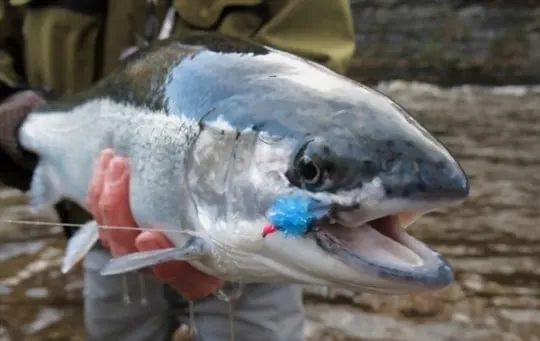
Steelhead is a freshwater fish that belongs to the salmon family.
It is native to North America and can be found in the Pacific Ocean as well as several inland rivers and lakes.
Steelhead is known for its flavor and texture, which makes it a popular game fish.
Steelhead is often referred to as rainbow trout because they are genetically the same species.
However, steelhead has more distinguishing features than rainbow trout.
Unlike Rainbow Trout, Steelheads migrate to the ocean before returning to their natal river or stream to spawn.
Another difference from Rainbow Trout is that Steelheads are bigger in size.
Steelheads usually live up to five years but some live longer than seven years which can cause them to reach four feet in length.
What is Atlantic Salmon?
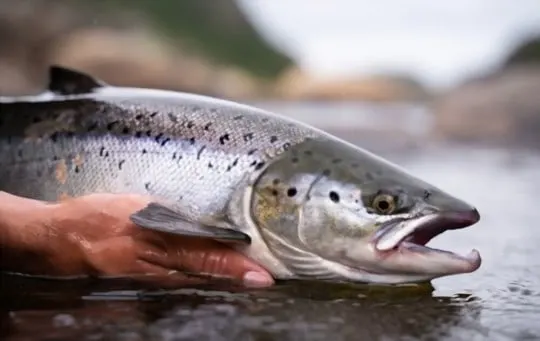
Atlantic Salmon is a popular fish species that is found in the Atlantic Ocean, as well as in rivers and streams that flow into it.
It is a member of the Salmonidae family, which also includes other well-known species such as trout and char.
Atlantic salmon is an anadromous fish, meaning that it spends most of its life in the sea but migrates to freshwater streams and rivers to spawn.
Atlantic salmon has been a prized food source for centuries and continues to be highly sought after today.
Its delicate flavor and texture make it an ideal choice for various dishes.
When it comes to their appearance, Atlantic salmon are typically silver with black spots on their dorsal area.
These spots are more prominent on younger fish but may fade as they mature.
They also have a distinctive tail fin that is slightly forked.
Finally, it’s important to note that Atlantic salmon populations have declined over the years due to overfishing and habitat destruction.
Various conservation efforts have been put in place to help restore their numbers.
Differences Between Steelhead and Atlantic Salmon
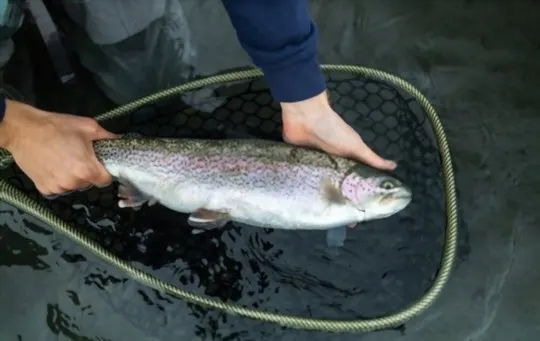
Steelhead and Atlantic salmon are two different types of fish that are often confused with each other.
In terms of their appearance, steelhead and Atlantic salmon differ in coloration and size.
Steelhead have a rainbow coloring on their sides and a silver belly while Atlantic salmon have a silver coloring with black spots on their sides.
During spawning season, Atlantic salmon also develop a red or pink underbelly, which is not seen in steelhead.
When it comes to size at maturity, both the male and female steelhead tend to be smaller than their Atlantic salmon counterparts.
The average sizes for mature steelhead are Males: 24-28 inches and Females: 28-34 inches while for Atlantic salmon they are Males: 24-30 inches and Females: 28-36 inches.
Overall, while they may look similar at first glance, there are clear differences between steelhead and Atlantic salmon that can help distinguish one from the other.
Origin and Habitat
Steelhead and Atlantic Salmon have different origins and habitats.
Steelhead is a type of rainbow trout that lives in the Pacific Ocean, while Atlantic Salmon, as the name suggests, can be found in the Atlantic Ocean.
Steelhead is a freshwater fish that migrates to the ocean and returns to freshwater for spawning, while Atlantic Salmon is predominantly a marine fish that migrates to freshwater for breeding.
The differences in their habitats are partly due to evolution.
For instance, Steelhead’s ancestors became adapted to living in very different environments as they moved from freshwater inland areas downstream toward the ocean.
They evolved partial tolerance to saltwater, which allowed them to live in both types of water.
In contrast, Atlantic Salmon evolved staying primarily in the Atlantic Ocean and moving up only specific rivers.
These two salmonids have differing migration patterns too; Steelheads move from deep oceans into freshwater or vice versa while migrating just once-over time while salmon, like the atlantic salmon migrates anadromously (meaning returning from marine environment back into fresh water) many times throughout their life cycle.
Appearance and Size
Steelhead and Atlantic salmon may look similar in many ways, but there are some notable differences between the two species.
To get a better understanding of these differences, let’s take a closer look at their appearance and size.
When it comes to coloration, steelhead tends to have rainbow-colored bodies with black spots on their back, tail, and caudal fin.
On the other hand, Atlantic salmon has brownish-blue bodies with silver sides.
They may also have black spots on their gill covers or above the lateral line.
In terms of size, both species can grow quite large.
Steelhead can reach lengths of up to 45 inches and weigh as much as 55 pounds.
Meanwhile, Atlantic salmon tend to be slightly smaller on average – around 26-30 inches in length – but they can still grow much larger than steelhead, reaching lengths of over 50 inches and weighing well over 100 pounds.
Overall, these differences in appearance and size can help distinguish between steelhead and Atlantic salmon, although it’s worth noting that individual fish can vary quite a bit depending on factors like age, diet, and habitat.
Taste and Texture
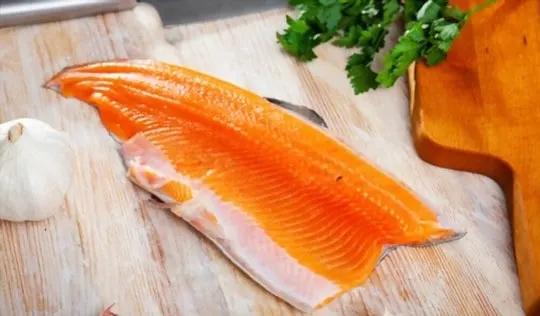
When it comes to taste and texture, both steelhead and Atlantic salmon have their own unique qualities.
Steelhead is known for having a mild, slightly sweet flavor that’s often compared to trout.
Its texture is firm and flaky, making it ideal for a variety of cooking methods such as grilling, smoking or baking.
On the other hand, Atlantic salmon has a richer taste with more pronounced flavors.
Its texture is also firmer than steelhead but not quite as flaky.
While steelhead has a milder and sweeter flavor with a flakier texture, Atlantic salmon has a richer flavor with firmer textures.
When cooking both fish varieties, it’s important to use ingredients that will complement their respective tastes.
Steelhead pairs well with citrus flavors like lemon or orange while Atlantic salmon pairs well with bold flavors like soy sauce or dijon mustard.
In summary, while both fish are delicious in their own ways, each has its preferred method of preparation based on its unique taste and texture characteristics.
Nutritional Value and Health Benefits
Steelhead and Atlantic salmon have been known for their nutritional value and health benefits.
These fish are a great source of protein, omega-3 fatty acids, vitamins, and minerals.
In fact, they are some of the healthiest fish that you can eat.
Both steelhead and Atlantic salmon are high in protein, which is essential for maintaining muscle mass and supporting healthy body functions.
They are also rich in omega-3 fatty acids that have anti-inflammatory properties that can help reduce the risk of heart diseases, stroke, and cancer.
Moreover, these fish contain various essential vitamins such as vitamin D which helps the body absorb calcium while also keeping bones strong.
Similarly, vitamin B12 plays an important role in healthy nerve function while selenium is an antioxidant mineral that helps protect against cellular damage.
Overall, consuming these fish on a regular basis can contribute to healthy digestion along with overall good health due to their nutrient-rich profile.
Culinary Uses and Cooking Methods
When it comes to cooking steelhead and Atlantic salmon, their similarities are more pronounced than their differences.
Therefore, you can prepare them in similar ways.
Both of them can be grilled, smoked, baked and pan-fried depending on your preference.
Smoking is a popular technique that helps balance the sometimes-strong flavor of both fish.
If you want to appreciate their delicate flavours, consider baking or grilling as both techniques cook the fish gently while retaining its nutrients.
When you bake these fishes, always remember to keep the temperature low so as not to dry out the meat.
Grilling is another excellent way of cooking these species.
You can opt for either an open flame grill or use a flat-top grill for convenience.
The secret here is to flip over the fish often gently to ensure even heat distribution.
Overall, steelhead and Atlantic salmon have almost identical culinary uses and cooking methods.
While both are versatile enough to satisfy most tastes buds, personal preference plays an essential role in how we choose which method suits us best.
Environmental Impact of Steelhead and Atlantic Salmon Fishing
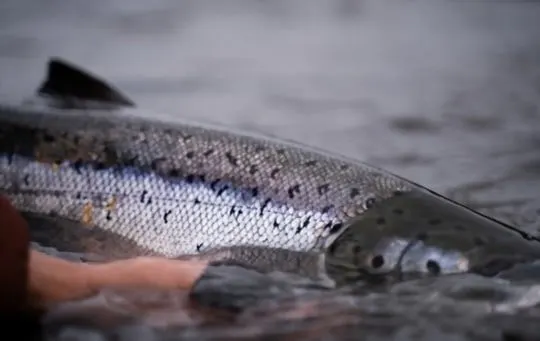
Fishing for both steelhead and Atlantic salmon has environmental impacts that can affect the ecosystem.
Both species are important to the environment and are considered a keystone species in many parts of North America.
These fishes help control populations of other aquatic animals by preying on them, while they also provide food for other animals like bears, bald eagles etc.
Overfishing is an issue in both cases since steelhead and Atlantic salmon reach maturity later than most other fish species.
This makes them more vulnerable to over-harvesting, thereby putting their populations at risk.
Additionally, habitat destruction is another significant consequence of fishing for these species since their habitats range from freshwater streams to estuaries and open ocean waters.
Furthermore, bycatch is a crucial factor associated with fishing as it results in unnecessary deaths of non-targeted fish species that get caught accidentally in nets or traps that fishermen use for catching steelheads or Atlantic salmon.
Moreover, habitat alterations like damming rivers for hydroelectric projects often change natural river flows, degrading water quality and hindering fish migration patterns.
In summary, fishing for steelhead and Atlantic salmon has significant environmental impacts that cannot be ignored.
It is necessary to take steps towards sustainable fishing practices while protecting the ecosystems where these keystone fishes play essential roles.
Conclusion
To summarise, we have examined the environmental impact of steelhead and Atlantic salmon fishing, comparing the two species based on their life-cycle, habitat requirements, and how they are managed in different areas.
We found that while there are similarities between steelhead and Atlantic salmon, there are also several key differences.
We can see that while both species require cool water for successful reproduction, there are significant differences in their life-cycles, habitats needs, and management practices.
Steelhead tend to be confined to specific river systems with colder waters due to their reliance on specific aquatic vegetation for food throughout their entire lifecycle.
On the other hand, Atlantic salmon exhibit more flexibility in terms of habitat use but must migrate long distances across vast ocean expanses which makes them vulnerable to overfishing.

Steelhead vs Atlantic Salmon: What’s the Difference?
Ingredients
- Steelhead
- Atlantic Salmon
Instructions
- Choose between two items based on your preference and availability.
- Follow the cooking directions for your chosen option, using the appropriate ratio of ingredients.
- Prepare it according to your desired recipes.
- Incorporate them into your dish, adjusting the amount to suit your taste.
- Enjoy the unique taste experience and experiment with different dishes to explore their versatility.

Andrew Gray is a seasoned food writer and blogger with a wealth of experience in the restaurant and catering industries. With a passion for all things delicious, Andrew has honed his culinary expertise through his work as a personal chef and caterer.
His love for food led him to venture into food writing, where he has contributed to various online publications, sharing his knowledge and insights on the culinary world. As the proud owner of AmericasRestaurant.com, Andrew covers a wide range of topics, including recipes, restaurant reviews, product recommendations, and culinary tips.
Through his website, he aims to inspire and educate fellow food enthusiasts, offering a comprehensive resource for all things food-related.
